Tunisia
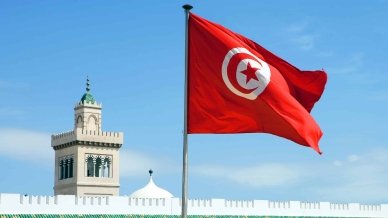
In this smallest North African country, a formal personal pronoun is used only for addressing the President. And here, a driving woman can hardly ever be detained by a police officer.
Tunisia amazes us with its past and present, culture and architecture, way of life, and people. Tourists from across the globe showed their appreciation for this uniqueness long ago. Annually, more than seven million people come here to spend their holidays.

General Information
Before gaining independence, Tunisia was under the rule of Phoenicians, ancient Romans, Byzantines, and Ottomans for several millennia.
The ruins of Carthage remind of glorious times of antiquity. It was a city-state that once existed in the suburbs of the current Tunisian capital. Nowadays, it is the open-air museum complex that has been included in the list of UNESCO World Heritage sites.
The last external rulers were the French that established their protectorate in Tunisia in 1883.
The monarchy existed till 1957. Since the beginning of the 18th century, the country was under the rule of the Husainid dynasty. Their reign ended with the abdication of the throne and the proclamation of the independent republic. As a result, times of peace and stability came.
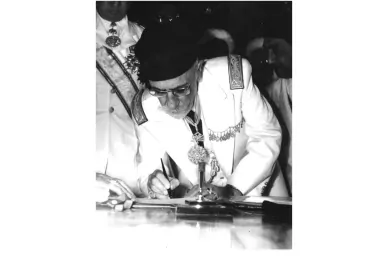
Muhammad VIII al-Amin, known as Lamin Bey - the last Bey of Tunisia
In the 1980s, Tunisia underwent the first of the two coup d’etats when President Habib Bourguiba was ousted from power. The country eventually got the multi-party system and chose the pro-Western direction of its development.
In 2011, the riots broke out again in Tunisia and ended with overthrowing the man who removed the first president from his office 30 years ago. Zine El Abidine Ben Ali was charged with creating the corruption network and his own clan that had usurped state power. The controversial website WikiLeaks provided incriminating information and published shocking materials about power abuse by the Tunisian governing elite.
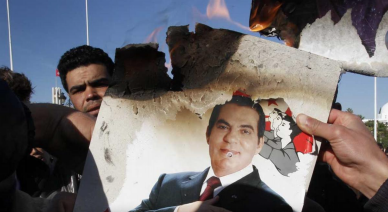
Strikers burn a photo of President Zine El Abidine Ben Ali during a protest
El Abidine escaped, and the state of emergency was declared till 2014. At present, the political situation in Tunisia has become stable.
Geography and Climate
Tunisia has terrestrial borders with Algeria and Lybia and marine ones with the Mediterranean Sea. The Atlas Mountains cover around 30% of the country’s territory. The other part is hardly suitable for life as there is a desert and savannah.
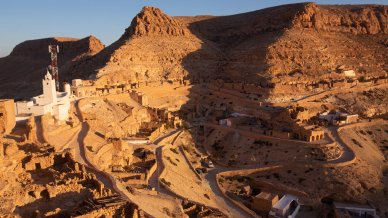
The cave village of Chenini in Tunisia’s southern desert.
Tunisian climate is a combination of subtropical and Mediterranean types and the tropical desert. It means that summer here is scorchingly hot, and the temperature reaches +45°C - +50°C between July and August. Nonetheless, during this period the prices of package holidays are rocketing. Moreover, the number of those willing to sunbathe on excellent beaches of Djerba, Sousse, or Yasmine is rising sharply.
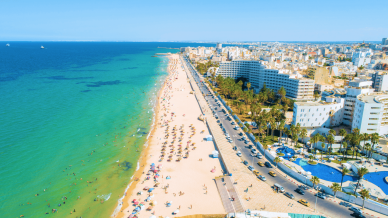
Beach in Sousse, Tunisia
Actually, the beach season begins in May and ends in October. And the best time to spend a holiday with children is in June when the water is warm, and the heat has not begun.
Winter is quite cold here, but the temperature of +20°C is comfortable for guided tours and suitable for walks and sightseeing.
However, the sea in winter is also cold because the temperature of coastal waters reaches only +15°C. But it does not prevent some adventurers from swimming even at this time.
The off-season is between November and October, but it does not mean that there are no tourists. Brave fans of jeep or camel racing in the deserts come here to enjoy specially organised tours to the Sahara.
Population, Language, and Currency
The population of the smallest Maghreb country is around 12.5 million people, and the majority of them are Arabs. The official language is Arabian, but they also speak French, which is a legacy of the former dominance of France in this tiny piece of the North African land.
Tunisia is a Muslim country, and only 2% of citizens adhere to Christianity, Buddhism, and other world religions.
The largest cities are the city of Tunis (650,000 residents), Sousse (275,000), and Sfax (200,000).
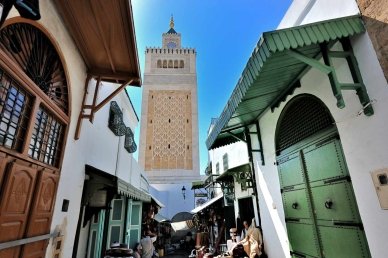
Old Town (Medina) in Tunis, Tunisia
The official currency is the Tunisian dinar, and the TND-USD exchange rate is 1:0.35, and TND-EUR is 1:0.31.
Directions
The best way of getting to Tunisia is travelling by air. There are direct flights from Europe, and transit flights from other parts of the world.
However, tourists may opt for charter flights to save some money. Airlines offer trips to the island of Djerba and resort cities of Monastir and Hammamet.
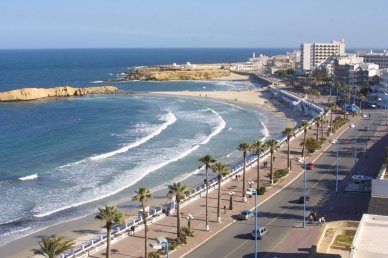
Al Qurayyah Beach, Monastir, Tunisia
Despite the low cost, charter flights may have some disadvantages:
- If some unforeseen circumstances occur, you will not be given a refund. The only way out is to find a person ready to purchase them from you.
- Travel mood and buying tickets in time may not guarantee 100% trip as the flight can be cancelled or delayed unexpectedly.
- A low-cost charter flight to Tunisia is perfect for families with children, but often it becomes inconvenient for other tourists. If you travel alone or cannot tolerate very noisy and energetic children, look for another flight then.
Besides the low cost, charter flights to Tunisia also have other advantages. For example, it is possible to buy the services of package holidays separately.
The air carriers that service flights to Tunisia in different parts of the globe are Air France, Lufthansa, Royal Air Maroc, Turkish Airlines, Qatar Airways, and many others. The main airport is Tunis-Carthage International.
Besides, foreign travellers can also reach the country by ferry from France and Italy. The main seaport is La Goulette in Tunis, from where tourists may take a taxi or a commuter train to the city centre.

Accommodation
As a rule, those who come to Tunisia opt for a hotel or a rented apartment.
The hotel network is well-developed, and all Tunisian hotels function under international compliance certificates. Every room has air-conditioning, comfortable furniture, and fresh bed linen. Moreover, hotels offer some extra services, like guided tours of local sightseeing places and journeys to the Sahara. High-speed Internet access and free Wi-Fi are available as well.
Friendly and responsible hotel staff also speak French and English. The other distinct advantage of all four- or five-star Tunisian hotels is close proximity to well-equipped white-sand beaches located within the first line, a minute walk from the sea.
Most Tunisian hotels are suitable for spending a holiday with children. There are children’s playgrounds and swimming pools with excellent entertainment performances.
Prices for rooms and rented accommodation usually depend on the time of the year. They are the highest between June and August, in the middle of the high season. A budget-friendly hotel room will cost at least $40, while the price for a rented apartment with little comfort will range from $30 to $50.
The highest prices are in the capital city — Tunis. Everything is very costly here, be it food, accommodation, or entertainment. Spending a holiday in Sousse, Hammamet, or Mahdia will require less money.
Below are several options of mid-priced hotels:
- Iberostar Selection Royal El Mansour is a five-star beach hotel in Mahdia. There are standard rooms and suites, several restaurants, swimming pools, and a thalassotherapy centre.
- Seabel Alhambra Beach Golf & Spa Port El Kantaoui is a four-star hotel in Sousse, located not far from the Gulf of Hammamet. The rooms are equipped with air-conditioning, TV sets, and mini-fridges. There are also some restaurants, swimming pools for adults and children, and clubs for kids and teenagers.
- Hotel Djerba Resort is a four-star hotel on the island of Djerba that offers a range of standards, suites, and family rooms with cots. In general, all rooms are fully equipped with the necessary things. Besides, there are restaurants, swimming pools, a thalassotherapy centre, clubs, and golf courses.
- Royal Karthago Resort & Thalasso is the other four-star hotel in Djerba. The rooms are equipped with a full set of appliances, and in winter — with central heating. The premises comprise a range of restaurants, cafes, souvenir shops, children’s playgrounds, a SPA, and a thalassotherapy centre. Families with kids may use the babysitting service and leave them in the playroom for some time.
- Hôtel Sentido Bellevue Park is a five-star hotel of the “all-inclusive” type in Sousse. There are safes, mini-fridges, mini-bars, and air-conditioning in each room. Besides, the hotel welcomes its visitors with restaurants, tennis courts, a thalassotherapy centre, and swimming pools.
Costs of rented accommodation vary: the cheapest options start with $30 during the season and with $20 in winter and autumn when the influx of tourists is not as huge. You may search for apartments via the airnbnb.co.uk platform as the choice there is very extensive, and all necessary information is provided.
Places to See
Sightseeing attractions of this most picturesque African country constitute a bright combination of legendary monuments of the past and the spirit of the present.
Carthage
Once, Carthage used to be the centre of the mighty empire created by the Phonecians. Though people have heard of it, not everyone may say where the exact site of its ruins is.
The former centre of the great state is located on the outskirts of Tunis. As it is the most visited attraction, public transport operates there on a regular basis. It will cost 12 TND to tour around this historical spot.
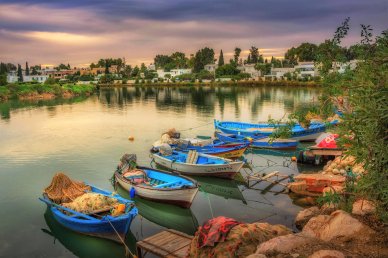
A small fishing harbour in the former Punic port of Carthage, Tunisia
If to compare this option with the guided tour offered by a hotel, the price for the latter will be ten times higher. What is more, local tour guides usually speak French, so non-French-speaking tourists will understand nothing from the stories told by the legendary ruins.
Tunisians have a talent for attacking the visitors to the country with all possible offers to help, be it a guided tour of the city or a walk to the local market, a disco, or even some crazy types of entertainment. But you will need to answer with a firm no.
So having paid 12 TND of the admission fee to Carthage, you will have a whole day to explore the site by yourself.
The most popular tourist destinations lie through a well-preserved aqueduct and amphitheatre with the capacity of around 50,000 people able to watch the gladiator games.
The other must-see attraction is the Baths of Antoninus Pius in Carthage. Once, this thermal complex was a place where all Carthage nobility gathered. The bathing was a background for business and friendly communication. Lying on wide benches, the statesmen were discussing important questions, enacted the laws, and, of course, enjoyed the tastiest delicacies to the fullest.
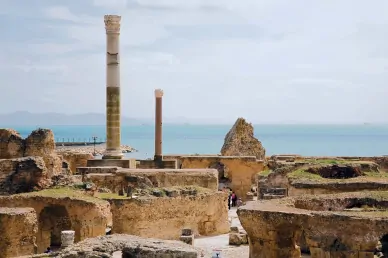
Ruins of Carthaginian baths in Tunisia
Excavations on the territory of Carthage have continued up to date. And every tourist has a chance to observe the well-known attractions and explore some newly discovered things.
Djerba
It is a typical spot of beach recreation, but still, there are many places worth rising from the deckchair to be spectated.
Djerba is an incredible combination of antique ruins, Arabic architecture, and breathtaking natural landscapes, which will leave an overriding impression on everyone walking around the island.
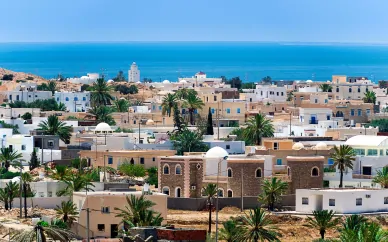
Djerba, Tunisia
Probably, the most romantic place in Djerba is the lagoon. The colonies of flamingos have favoured it and thus gather there for a real feast. Standing on their thin legs right in the water, they masterfully catch crayfish and every other living thing and eat it immediately.
Just imagine the coast of the turquoise lagoon at the gentle pink background of flamingos’ feathers. The unbelievable spectacle will take your breath away.
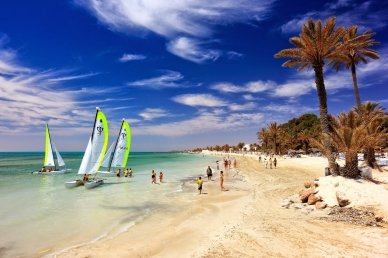
Beach on the island of Djerba
Another must-see spot is the Jerba Explore Park. Nature lovers and those keen on ancient history and arts will find their type of entertainment there.
Have you ever fed crocodiles? Have you seen them dividing the spheres of influence and fighting for their females, biting off the noses of each other? Even if you are indifferent to crocodile affairs, visit the island’s crocodile farm. You will be impressed. This tour can become a real discovery for those who could see the Nile crocodiles only in the Animal Planet programmes.
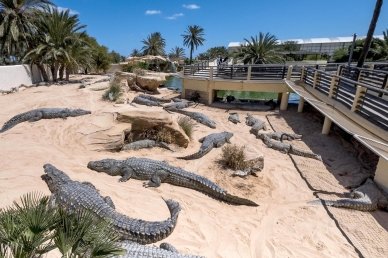
The crocodile park on the island of Djerba
Antique ruins, Arab and Turkish mosques, and El Ghriba Synagogue are the legacy inherited by Djerba island from ancient civilizations that had existed before. Touring the monuments of antiquity is an opportunity to plunge into its atmosphere at least for a couple of hours.
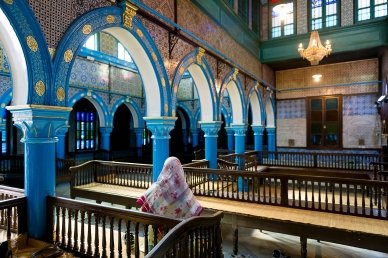
El Ghriba Synagogue, Djerba, Tunisia - the oldest synagogue in Africa
Le Bardo
If art connoisseurs come to Tunisia, they aspire to visit a suburb of its capital. There is the Bardo National Museum, the concentration of unique artifacts of antiquity.
Six museum displays dedicated to the history of humanity from prehistoric times till the present day have been housed in the Hafsid palace, constructed 800 years ago.
The exhibits include a range of ceramic panels, Moresque wood paintings, Mahdia treasures, antique and Arab vases, and other art pieces of ancient times.
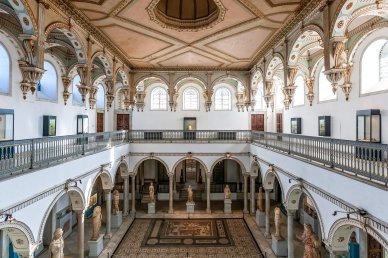
Bardo National Museum, Tunis, Tunisia
Food
The national cuisine of Tunisia is not exactly the food served at a hotel restaurant. Authentic food is in tiny cafes that families of local people have owned from generation to generation.
The number one dish is couscous, or small granules of durum wheat semolina, the cooking of which is complicated enough. As well as in Morocco, couscous is cooked at home and boiled in a very sophisticated way.
This porridge is served with vegetable salads, fish, and seafood. The Tunisians do not eat meat as it is very expensive.
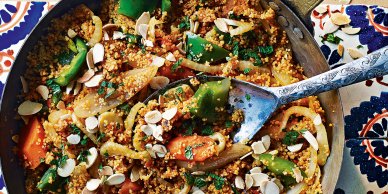
Tunisian couscous
In Tunisia, they also like to eat pastry, for example, small pies called briki made of thin Malsouka dough and filled with mashed potato, eggs, fish, and green stuff. Deep-fried briki is a compulsory dish at night during the holy month of Ramadan.
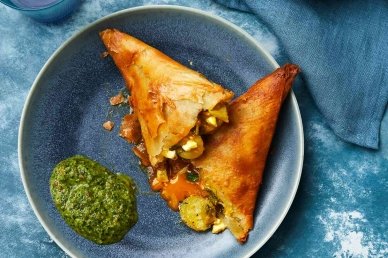
Tunisian Briki
Dinner usually begins with several snacks served in flat bowls that resemble meze (a popular Muslim and Balkan appetizer). As a rule, these spicy snacks are cooked of fish, vegetables, cheese, and nuts and are called kemia.
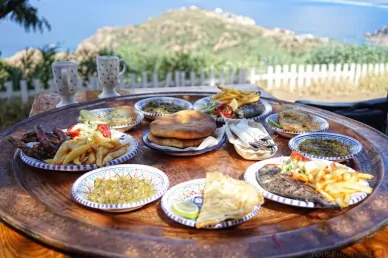
Tunisian kemia
The next course is a hot spicy soup (chorba or any other) followed by vegetable salads containing couscous, fish, and sometimes mutton or chicken. As in any other Muslim country, they do not consume pork in Tunisia. It is regarded as haraam here.
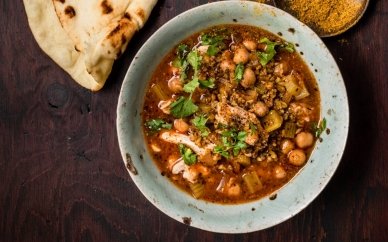
Chorba chicken soup
Tunisian desserts are very similar to the French ones due to the long-time dominance of France on the African continent. As a rule, these are fresh crunchy croissants with coffee, tea, or milk, exquisite pains au chocolat made of laminated dough, and various fillings.
Oriental charm is intensified by fruit, sorbets, lokum, baklava, and, of course, dates — very sweet and aromatic delicacies.
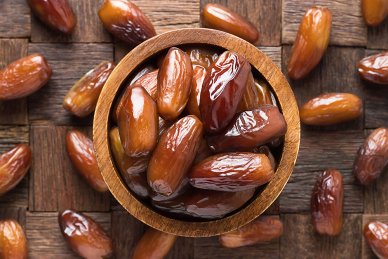
Tunisian Dates
Food at local cafes and restaurants is inexpensive: a dinner for two will cost around 40 - 50 TND.
Perhaps, at present, the level of service offered in Tunisia is not as high as the European one. But there are warm African hearts, amiability, hospitability, and the mystic beauty of ancient times. Give yourself a chance to see and feel it firsthand.
FAQ
What is Tunisia's actual name?
The official name of Tunisia is the Tunisian Republic.
What is the area of Tunisia in km²?
Tunisia covers an area of about 163,610 square kilometers.
Is Tunisia in Africa or Europe?
Tunisia is located in North Africa.
How many countries border Tunisia?
Tunisia shares its borders with two countries: Algeria to the west and southwest, and Libya to the southeast.
What is the capital of Tunisia?
The capital of Tunisia is Tunis.
What is Tunisia's population?
Tunisia's population is approximately 12.5 million people.
What are the 3 main religions in Tunisia?
The main religion in Tunisia is Islam. Minority religions include Christianity and Judaism.
What language does Tunisia speak?
The official language of Tunisia is Arabic. French is also widely used in education, business, and the media.
What type of government is Tunisia under?
Tunisia is a unitary semi-presidential representative democratic republic.
Which currency does Tunisia use?
The currency of Tunisia is the Tunisian Dinar (TND).
How is the economy in Tunisia?
Tunisia has a diverse economy, including agriculture, mining, manufacturing, and petroleum products, but it faces challenges like unemployment and regional disparities.
Is Tunisia good for tourists?
Tunisia is popular among tourists for its Mediterranean beaches, historical sites, and desert landscapes.
Do I need a visa for Tunisia?
Visa requirements for Tunisia vary by nationality. Many nationalities can enter Tunisia without a visa for short stays, but others will require a visa.
What's the best month to visit Tunisia?
The best months to visit Tunisia are from April to June and from September to October, when the weather is mild and pleasant.
What is Tunisia best known for?
Tunisia is known for its diverse cultural history, Mediterranean coastline, ancient ruins like Carthage, and its part in the Arab Spring.
Is Tunisia cheap?
Compared to many Western countries, Tunisia is relatively inexpensive for tourists, though prices can vary by region and season.
Can you use euros and dollars in Tunisia?
Euros and US dollars can be exchanged in Tunisia, but they are not commonly accepted for transactions. It's best to use the local currency.
Is it safe to holiday in Tunisia now?
While Tunisia is generally safe for tourists, it's advisable to stay updated on travel advisories and exercise standard safety precautions, especially in tourist areas.







